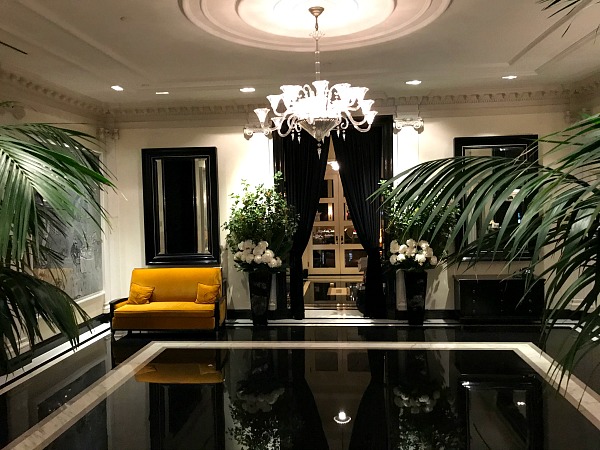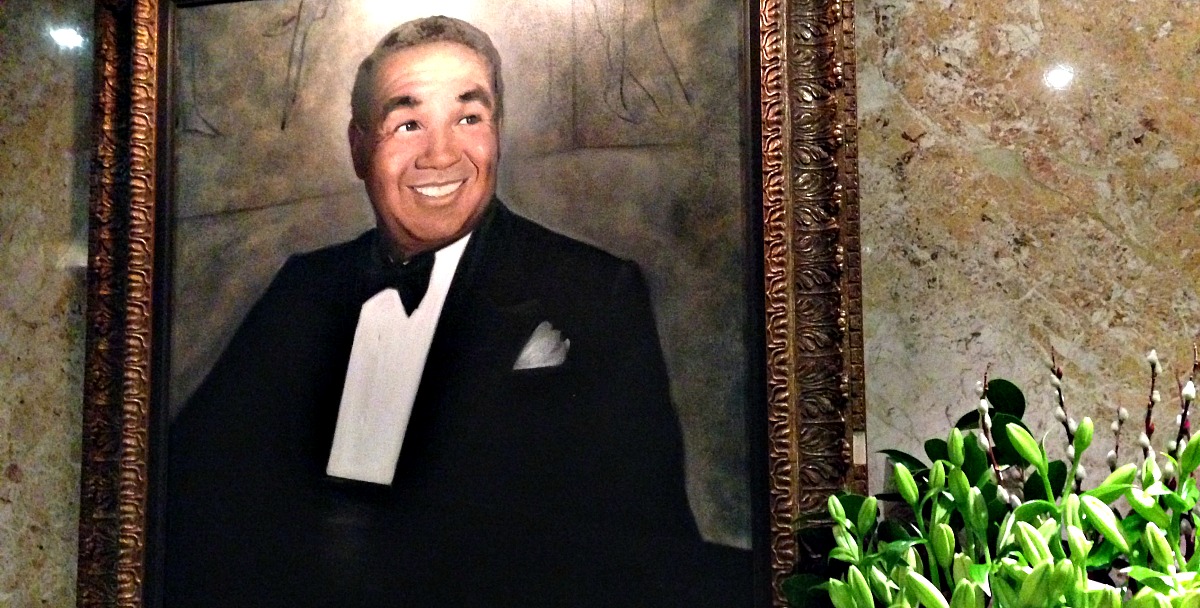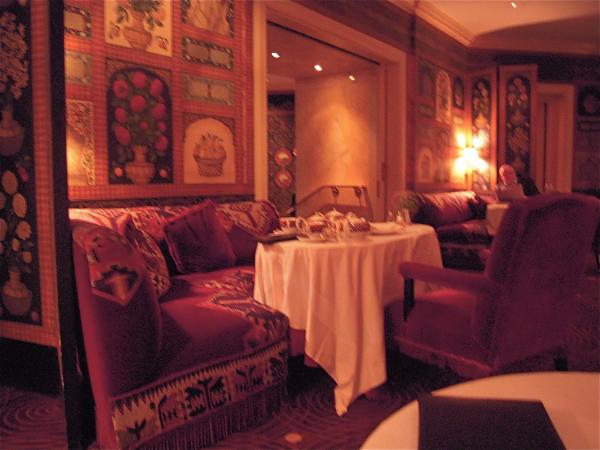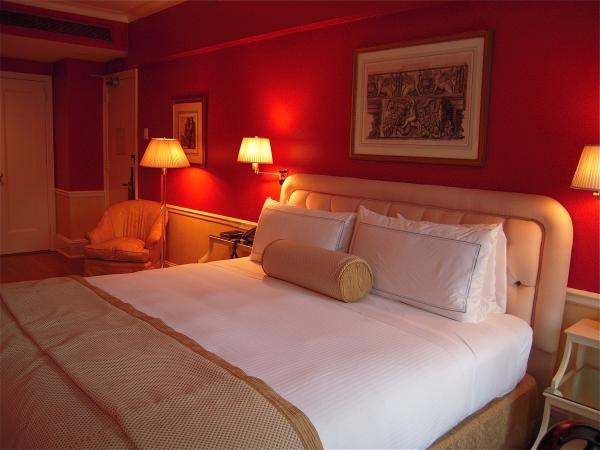Socialites, Lapsang Soochang and Carla Bruni — A Night at The Carlyle
The uniformed attendants posted behind a discrete desk in the grand black-and-white lobby were impeccably polite. But check-in wasn’t unspooling quite as I expected. The man next to me, owner of a blue blazer and a belligerent British accent, waved a sheet of paper and demanded to know what the devil these bloody charges were.

The Carlyle check in area (Overnight New York photo)
I, meanwhile, stood and waited – and waited – and waited. I’d supplied a credit card, cell phone number and e-mail address. I’d learned in detail about the hotel’s various services – yes, I’d be sure to have a drink in Bemelmans Bar, and the spa sounded divine. But I still didn’t have my key.
At last the truth emerged – my room wasn’t ready, even though it was nearly 5 pm. (Ahem.)
But before I could ask if a different room was available – a complimentary upgrade perhaps? — the attendant spoke softly into a telephone, apologized for the delay and handed me a key – heavy metal instead of a plastic card. “You have a beautiful room,” she said. “Have a lovely stay.”
It was as if she lifted a velvet rope. I was in, and the serene, silky world that is The Carlyle – a heady mix of time-warp glamour, East Side hauteur and contemporary creature comforts – unfolded. To my left stood a table laden with lemon water and a fleet of glasses capped with white paper lids. To the rear, the elevators, each manned – yes, manned – by a liveried attendant wearing white gloves. And was that man striding past the lobby’s Legers sporting a hotel bathrobe? He was and nipped into the elevator, an escapee from the spa.

Bobby Short, the Carlyle’s legendary cabaret artist, immortalized in a hallway near his long-time haunt, Cafe Carlyle
With its 35-story terracotta tower and classic black and gold awning, the Carlyle looks every inch a grand hotel. But it feels like a club, a more stylish branch of the University or Metropolitan or even the NYAC. Rooms are called apartments, and guests often check in for weeks. Bemelmans Bar and the Gallery, where afternoon tea is served, are like canteens with regulars culled from the neighborhood, the art world and literary circles. Over tea (excellent Lapsang Soochang and generous crust-free sandwiches), I watched as a wraithlike socialite at the next table presented her teen-age daughter, an aspiring writer, to an editor at a prominent magazine. (“Do you have any clips? Oh, don’t worry about it.”)
Like many octogenarians, the Carlyle has occasional less-than-sure-footed moments. But for the most part, this sleek, timeless, brazenly unhip establishment is a nimble time traveler. Spend the night, and you can imagine yourself hobnobbing in an idealized New York – a Fred and Ginger movie (with updated plumbing) or a Woody Allen film (without the angst), soundtrack by Bobby Short. You can also climb into a fiendishly comfortable bed, nibble a turndown chocolate and curl up with premium cable.
The hotel, named for the Victorian essayist Thomas Carlyle, comes by its retro glamour naturally. Though this Art Deco concoction opened in 1930, an inauspicious year for new ventures, composer Richard Rodgers was the first tenant. Dorothy Draper did the interiors. And because an early owner collected art, original Audubon and Piranesi prints bedeck the rooms (a handsome Piranesi hung over my bed).

Tea at the Carlyle
With its Upper East Side locale twenty blocks north of Midtown, the Carlyle was a neighborhood perch, more so than contemporaries like the Pierre and Waldorf Towers. At one time social references were required to obtain an apartment.
It’s still discreet, attracting an intriguing crowd. I saw Warren Beatty and Annette Bening in the lobby a while back. French President Nicholas Sarkozy and Carla Bruni visited last month for the UN General Assembly. And given the military-suited guard positioned outside Bemelmans Bar the evening of my stay, his barrel chest plastered with metals, at least one international bigwig was on the premises. I wouldn’t know. The bar, garnished with Ludwig Bemelmans’ impish murals, was so moodily dark I could barely see my Vesper (at $20, pricey but potent) and a generous helping of mixed nuts in a silver server. Fortunately, pianist Chris Gillespie’s jazzy renderings of “Somewhere Over the Rainbow” and other standards came in sweet and clear.
My sixth-floor room facing Madison Avenue – too low, alas, for a Central Park view – was a primer in Carlyle-style luxury: understated (hardwood floor, large area rug), comfortable with antiques and blithely unconcerned with trends. The most lavish stroke was its size. It sprawled, sufficiently large to make the king-size bed — the brocade bedspread folded at the foot during the day was stashed at night — seem an accoutrement rather than a centerpiece.

The Carlyle dining room
As if harvested from a classic Park Avenue prewar apartment, the inviting 20th-century décor hinted of Mark Hampton: red-papered walls, wheat- papered wainscoting and whipped cream white beamed ceiling. Twin porcelain-based lamps flanked the large wood dresser opposite the bed. A silver Panasonic flatpanel HD TV perched on a painted white stand. And between the two tall windows, dressed in floor-kissing curtains and sheers Edith Wharton would have appreciated, a pert, glass-topped, French-inflected writing desk. Though more than capable of supporting our laptop, it’s raison d’etre seemed letter writing (engraved Carlyle note cards were tucked in the drawer).
One odd note was the headboard fashioned from cream-colored woven fabric. It was spotless, but I wondered how long it would stay that way.
What looked like a full-length mirror in a corner turned out to be the inside of the bathroom door, left open and outfitted with a hook for two Frette bathrobes. The mirror’s import was immediately clear. The bathroom was so small the scale was tucked inside the vanity, along with the hairdryer.

My room
The teeny bathroom was, in fact, a hall of mirrors, though was it necessary to plant a one directly opposite the toilet? Creamy marble blanketed the few non-reflective surfaces, like the wall backing the large, glassed in tub/Jacuzzi/shower combo (excellent shower, btw). And I loved the fresh orchids on a glass shelf, along with a generous selection of Kiehls bath products.
The walk-in closet, in contrast, was gargantuan, big enough to hold a mountain of steamer trunks or the spoils of a shopping spree and thoughtfully outfitted with a pair of tray tables for breakfast in bed and a minibar, stocked with assorted glasses, nibbles and libations. A modest refrigerator displayed soft drinks and champagne. Minibars are like casinos – the house always wins. But it was late, and when I saw a classic bottled Coke – no crass cans! – I couldn’t resist, even at $7 (plus tax).
My Coke a-fizz in a sleek old-fashioned glass, I climbed into bed. The mattress was bliss, the Yves Delorme sheets crisply soft, the down comforter just right. The Carlyle gets a lot just right, I thought as I drifted off to sleep.

What a wonderful description of the Carlyle and its guest rooms. As a resident at 81st and Madison in the late 1970s and throughout the 1980s, I walked past the Carlyle at least once a day; it seemed to anchor the neighborhood. An old friend used to take me to the Carlyle’s restaurant for Sunday brunch on occasion–we ordered baby lamb chops and champagne. It seems the Carlyle is still a home away from home for movie stars. For years, Paul Newman and Joanne Woodward kept an apartment there. It was fun to watch women spin round and do astonished double takes when Newman strolled up Madison Avenue on his way to the hotel’s entrance. The Carlyle was where Angelica Huston and Jack Nicholson stayed when they visited New York. No doubt the Carlyle staff is above average in its ability to make celebrities feel buffered from the public. I have happy memories of the Carlyle as a neighborhood fixture–there could be no more cozy, luxurious bar anywhere than Bemelman’s, I have always felt–but I never had a reason to spend the night at the hotel. I was always curious. Your description is so wonderfully detailed; I feel as if I know what it might be like, now. Thanks Overnight New York.
A place with lots of history and nice touches, from Richard Rodgers to the Vesper (thank you, 007).